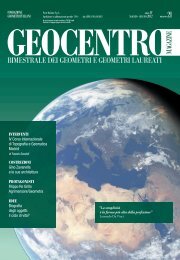Geocentro Magazine - numero 6 - novembre/dicembre 2009
Geocentro Magazine - numero 6 - novembre/dicembre 2009
Geocentro Magazine - numero 6 - novembre/dicembre 2009
You also want an ePaper? Increase the reach of your titles
YUMPU automatically turns print PDFs into web optimized ePapers that Google loves.
70<br />
ANNO I | n. 6 | NOVEMBRE - DICEMBRE <strong>2009</strong><br />
Leonardo da Vinci,<br />
Carta della Valdichiana<br />
Leonardo da Vinci,<br />
Map of Valdichiana<br />
che per Leonardo ha il loro profondo studio: “Di molto<br />
maggiore investigazione e speculazione sono le ombre nella<br />
pittura che i loro lineamenti; e la prova di questo s’insegna<br />
che i lineamenti si possono lucidare con veli, o vetri piani<br />
interposti fra l’occhio e la cosa che si deve lucidare; ma le<br />
ombre non sono comprese da tale regola, per l’insensibilità<br />
dei loro termini, i quali il più delle volte sono confusi”<br />
(Leonardo da Vinci, Libro di Pittura).<br />
Così, è da riscontrare il geniale uso di luce ed ombra, adottato<br />
per la Carta dell’Italia centro-nord, nella quale Leonardo<br />
introduce una modalità di rappresentazione che consente<br />
una percezione delle variazioni di quota del territorio<br />
cartografato, senza precedenti nella storia della Cartografia,<br />
e che può essere riconosciuta come l’archetipo della tecnica<br />
di rappresentazione orografica a tinte ipsometriche, ancora<br />
oggi adottata per la realizzazione degli atlanti scolastici del<br />
nostro tempo e riproducente con efficacia ed immediatezza il<br />
concetto di “più scuro più alto”.<br />
not, they are undefi ned or uncertain...” (Leonardo da Vinci,<br />
c. 1508-10).<br />
Th erefore, we have to take into account the clever use of lights<br />
and shadows in the Carta dell’Italia centro-nord (Windsor,<br />
RL 12277). In this map, Leonardo introduces a new way of<br />
representation that makes it possible to perceive the diff erences<br />
of altitude in the landscape. Such a method had never been<br />
previously applied in cartography and constitutes the archetype<br />
of the way to represent an altitude through hypsometric colours<br />
(a method nowadays still in use for school atlases and a<br />
practical and understandable example of the abstract concept<br />
“the darker, the higher”).<br />
Together with the representation of a mountain shape, even<br />
Leonardo’s hydrographical sketches are a demonstration of the<br />
same idea of three-dimensionality, obtained with the same<br />
method, although with the opposite concept “the darker, the<br />
deepest”. Th e best example is the Carta della Valdichiana<br />
(Windsor, RL 12278r), where the shallow stretch of water<br />
in the valley contrasts with the deepest waters of its tributary<br />
fl ows, thanks to the use of diff erent tones of blue for every level<br />
of depth.<br />
Windsor Castle, Royal Library, 12278r






